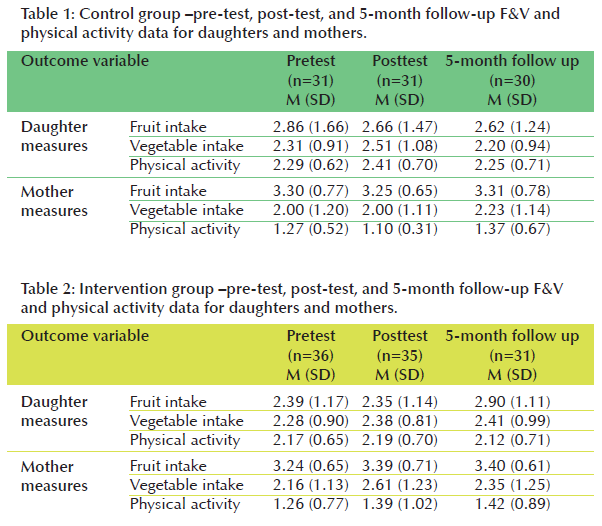A web-based, health promotion program for adolescent girls and their mothers who reside in public housing: focus on F&V consumption and physical activity
Adolescent girls who live in public housing are at risk for poor health outcomes owing to their socio-economic status. This work tested a brief web-based , family-involvement health promotion program aimed at drug use, physical activity, and nutrition for adolescent girls, aged 10 to 12 years, who reside in public housing.
The study comprised 67 mother–daughter dyads who were randomly assigned to the intervention or control arm. Girls and mothers completed their respective baseline measures online.
Subsequently, intervention-arm dyads completed the 3-session health promotion program on a secure website:
- Session 1 focused on active listening, communication, and the benefi ts of family meals.
- In session 2, mothers and daughters discussed their knowledge about drugs. Mothers learned to set and enforce rules. Dyads learned strategies to make healthy and economical decisions at the grocery store and how to make healthy dinners.
- Session 3 dealt with coping skills. Drawing from a list of stressors that reflect the hardships of living in public housing, dyads identified and shared with each other sources of stress. Mothers and daughters were also exposed to a 5-step problem solving process.
Control-arm dyads received no intervention materials. All dyads completed posttest and 5-month follow-up measures. In this article, the focus is on the evolution of fruit and vegetable consumption, and physical activity before and after the promotion program.
Evaluation on F&V intake and physical activity
Fruit and vegetable intake was evaluated with 21 items from the Youth and Adolescent Food Frequency questionnaire. Mothers and daughters reported how often they consumed certain foods per week (“0 times per week” = 1 to “more than 7 times per week” = 6) – Table 1 and 2.
Physical activity was evaluated with 12 items from the Kaiser Physical Activity Survey. Eight of the items evaluated the types of activities girls and mothers typically engaged in each week. These eight items used a 5-point Likert scale (“0 times per week” = 1 to “more than 7 times per week” = 6). The other four items assessed the number of hours that girls and mothers spent on such activities as “watching TV” or “surfing on the Internet” (“less than 1,” “1,” “2,” “3,” or “more than 3 hours per week”) – Table 1 and 2.

Increasing vegetable intake and physical activity among mothers with web-based health promotion program At post-test and relative to the control arm, girls and mothers who received the health promotion program reported greater mother–daughter communication. Intervention-arm girls also reported more parental monitoring. Intervention-arm mothers reported greater closeness to their daughters, increased vegetable consumption and increased physical activity.
Increasing fruit intake among girls with web-based health promotion program
At 5-month follow-up, time by intervention interaction results showed that over time, intervention-arm girls demonstrated greater mother–daughter communication, closeness, increased fruit consumption, reduced psychosocial stress, and greater drug use refusal skills, relative to control-arm girls. Intervention-arm girls and mothers reported increased parental monitoring.
| Findings suggest that a brief, web-based health promotion program for such girls and their mothers can affect positive and relatively sustained changes in health behavior and salient risk and protective factors. Girls and mothers improved their scores on measures of communication, closeness, and parental monitoring. |
Based on: Schwinn TM, Schinke S, Fang L, Kandasamy S. A web-based, health promotion program for adolescent girls and their mothers who reside in public housing. “Addict Behav. 2014 Apr;39(4):757-60.
